NEW YORK — Naomi Osaka began the U.S. Open seeded 20th, having never made it past the fourth round of a Grand Slam tournament. She also arrived with big goals.
“It would be really sad if I kept playing for years and my biggest goal was to get to the quarters of a Slam,” she announced after her first-round victory. “I think everyone plays Slams to win, especially the younger players now.”
Look at her now. Two weeks later, the 20-year-old is, indeed, a major champion after thoroughly outplaying and beating her idol, Serena Williams, while keeping her composure during a Grand Slam final as chaotic as anyone can recall.
Now, as thoughts turn to 2019, there’s no reason to think Osaka won’t have more in store. She is at the forefront of the next generation in women’s tennis, someone possessing quite a mixture of powerful serve and strokes, enviable court speed and a preternatural calm.
Or at least she appears to never get rattled on court.
But ask her how she felt Saturday morning before the final.
“I woke up and I was sweating. I was so nervous. My heart was racing, like, the entire day,” Osaka said.
She spoke via video chat with her sister, who told Osaka to think of the match against Williams as just another match.
“Are you crazy?!” was Osaka’s reply. “It’s a Grand Slam final!”
It was her first. And now she’s the first player from Japan to win one. Osaka was born there, to a Japanese mother and a Haitian father, and moved to New York at age 3. Now she’s based in Florida.
Osaka was the biggest revelation at this U.S. Open – who could be surprised at Novak Djokovic’s winning his 14th major title? – but plenty else happened over what undoubtedly was as wild a Grand Slam tournament as there’s been in years.
Here is what else we learned:
TENNIS NEEDS CHANGES
The whole clash between Williams and chair umpire Carlos Ramos showed that there are inconsistencies with officiating and questions about the place of coaching. That Williams lost a point, then a game, and was fined $17,000 are what will be remembered about that final.
DJOKOVIC IS BACK
Djokovic’s second major title in a row, after Wimbledon in July, signaled fully that he is once again at the height of his powers. His coach, Marian Vajda, said Djokovic peaked from the quarterfinals on, and it’s tough to argue. He claimed the last 16 sets he played. This followed a two-year Slam drought for the 31-year-old Serb, who suddenly is tied with Pete Sampras for the third-most major trophies by a man, trailing only Roger Federer’s 20 and Rafael Nadal’s 17.
SO IS DEL POTRO
He didn’t win the title, but Juan Martin del Potro got to a major final for the first time since his U.S. Open triumph in 2009. After years of struggles and time away because of four wrist operations, his rebuilt backhand and strong-as-ever forehand make him a contender once again.
EXPECT THE UNEXPECTED
So much to talk about. Simona Halep’s loss, the first by a No. 1 seed in the first round at the U.S. Open. The suffocating heat and humidity that prompted the U.S. Tennis Association to create rules on the fly. Chair umpire Mohamed Lahyani’s impromptu counseling session with Nick Kyrgios (not allowed). The flap over the chair umpire who told Alize Cornet she couldn’t change her shirt on court (allowed). Federer’s jaw-dropping, around-the-net-post trick shot against Kyrgios in the third round. Federer’s five-set loss to 55th-ranked John Millman in the fourth. Victories that finished after 2 a.m. for 2014 champ Marin Cilic and Nadal. And Nadal’s retirement from his semifinal against del Potro because of a knee injury.
Send questions/comments to the editors.



Success. Please wait for the page to reload. If the page does not reload within 5 seconds, please refresh the page.
Enter your email and password to access comments.
Hi, to comment on stories you must . This profile is in addition to your subscription and website login.
Already have a commenting profile? .
Invalid username/password.
Please check your email to confirm and complete your registration.
Only subscribers are eligible to post comments. Please subscribe or login first for digital access. Here’s why.
Use the form below to reset your password. When you've submitted your account email, we will send an email with a reset code.